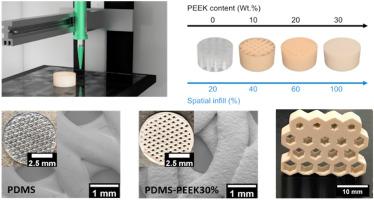Journal of the Mechanical Behavior of Biomedical Materials ( IF 3.3 ) Pub Date : 2021-01-05 , DOI: 10.1016/j.jmbbm.2020.104291 James A. Smith , Simin Li , Elisa Mele , Athanasios Goulas , Daniel Engstrøm , Vadim V. Silberschmidt

|
Polydimethylsiloxane (PDMS) materials are widely adopted in the manufacture of facial prostheses, lab-on-chip devices and scaffolds for soft-tissue engineering applications; however, their processing by additive manufacturing (AM) has proved challenging. Liquid silicone rubbers (LSRs) are favoured for their high shape fidelity when cast, but their low viscosity and surface tension often prevent self-support, post-extrusion. Poly(ether) ether ketone (PEEK) particle reinforcement through interfacial bonding has proven to enhance key properties of PDMS, expanding their end-use functionality. Still, the impact of such particles on the printability of LSR-PDMS is not explored. In this study, for the first time, solvent-free biocompatible PDMS-PEEK composites (up to 30 wt% PEEK) were successfully characterised for material extrusion (ME) printing. Rheological analysis confirmed shear-thinning of all PDMS-PEEK composites under applied load (within the tolerances of the printer) and dominant storage moduli at rest (i.e. prints can self-support), considered highly desirable for ME-based printing. Attained rheological datasets were used to guide initial printability studies, which revealed finer track fidelity with rising fractional content of PEEK, at comparable print speed and displacement values. Composites with higher PEEK content demonstrated significant increases in Shore A hardness and stiffness (in tension and compression) in bulk form. Last but not least, enhanced shape fidelity (thanks to PEEK reinforcement) and geometrical autonomy further expanded the manufacturing freedom of PDMS, whereby infill density could be controlled in order to increase the range of mechanical performance, previously unachievable with conventional casting fabrication. Fundamentally, this could lead to the manufacture of bespoke spatially graded multi-material structures and devices that could be used to replicate the heterogenous properties of soft human tissues and in other advanced material applications.
中文翻译:

用于材料挤出的生物医学PDMS-PEEK复合材料的可印刷性和机械性能
聚二甲基硅氧烷(PDMS)材料被广泛用于制造面部假肢,芯片实验室设备和用于软组织工程应用的支架。然而,事实证明,通过增材制造(AM)对其进行加工具有挑战性。液态硅橡胶(LSRs)因其浇铸时的高形状保真度而受到青睐,但其低粘度和表面张力通常会阻止自支撑,后挤出。通过界面粘合增强聚醚醚酮(PEEK)颗粒已被证明可以增强PDMS的关键性能,从而扩展其最终用途。仍然没有探索这种颗粒对LSR-PDMS可印刷性的影响。在这项研究中,首次成功地将无溶剂生物相容性PDMS-PEEK复合材料(高达30 wt%PEEK)用于材料挤出(ME)印刷。流变学分析证实了所有PDMS-PEEK复合材料在施加负载(在打印机的公差范围内)和静止时的主要储能模量(即打印可以自我支撑)下的剪切稀化,这被认为是基于ME的打印非常理想的。所获得的流变数据集可用于指导初始可印刷性研究,该研究显示在可比较的印刷速度和位移值下,随着PEEK分数含量的增加,轨迹保真度更高。具有较高PEEK含量的复合材料散装形式的肖氏A硬度和刚度(在拉伸和压缩状态)显着提高。最后但并非最不重要的一点是,增强的形状保真度(归功于PEEK的增强)和几何自主性进一步扩展了PDMS的制造自由度,从而可以控制填充密度以扩大机械性能范围,以前是传统铸造工艺无法实现的。从根本上讲,这可能会导致制造定制的空间渐变多材料结构和设备,这些结构和设备可用于复制人体软组织的异质特性以及在其他高级材料应用中使用。











































 京公网安备 11010802027423号
京公网安备 11010802027423号